ISSN ONLINE(2319-8753)PRINT(2347-6710)
ISSN ONLINE(2319-8753)PRINT(2347-6710)
C.Chaithanyan1, H.Venkatasubramanian1, Dr. S.Raghuraman2, T. Panneerselvam3
|
| Related article at Pubmed, Scholar Google |
Visit for more related articles at International Journal of Innovative Research in Science, Engineering and Technology
Composite materials have occupied major part in current era due to its light weight, good stiffness, high specific strength and flexible nature. Due to large availability of naturally occurring fibers and their capability to hybridize with glass fiber, the applications of these fibers vary according to purpose. This paper deals with preparation and investigation ofhybrid composites of natural fibers in isophthalic polyester resin.Natural fibers used here are sisal and coir fibers which are mixed with isophthalic polyester in volume fraction basis of 0.4 & 0.5. This composite is manufactured using hand layup process. Mechanical properties of each composite are determined through tensile, flexural, impact tests. The tensile strength of sisal-glass composite is found to be better than the coir-glass composite. The flexural strength and impact strength of sisal-coir-glass hybrid composite is found to be better than the remaining two combinations of composites.
Keywords |
| Coir, Sisal, Isophthalic polyester, |
INTRODUCTION |
| Extensive Research has been dedicated towards developing light weight fibre composite structures with superior mechanical properties like high fracture toughness, low notch sensitivity, specific strength etc. Glass fibre reinforced Composites possess these qualities and are extremely versatile. Polymer matrix Composites are much easier to fabricate than metal-matrix, carbon-matrix and ceramic-matrix composites because the polymers have the good capability to bond with fibres and adds strength to the composites. In the latest years, there are many researchesconducted in the field of natural fiber reinforced plastics (Bledzki & Gassan, 1999). Most of them are based on the study of the mechanical properties of composites reinforced with short fibers. The components obtained therefore are mostly used to produce non-structural parts for the automotive industry such as covers, car doors panels and car roofs (Magurno, 1999, John at al., 2008).Few studies deal with structural composites based on natural reinforcements. These studies are mainly oriented to the housing applications where structural panels and sandwich beams are manufactured out of natural fibers and used as roofs (Saheb & Jog., 1999).Thus the usage of the natural fibers has been increased in the recent past, due to their lightweight, nonabrasive, non-irritating, combustible, nontoxic, biodegradable properties (Saheb & Jog, 1999), low energy consumption for production, budget zero CO2 emissions if burned, low cost, main availability and renewability compared to synthetic fibers, has resulted in a large number of applications to bring it at par and even superior to synthetic fibers. Because of such properties natural fibers are fast emerging as a viable choice as reinforcing material in composites (Kalia et al., 2009).Now-a-days natural fibers such as sisal and jute fiber composite materials are replacing the glass and carbon fibers owing to their easy availability and cost. |
| The use of natural fibers is improved remarkably due to the fact that the field of application is improved day by day especially in automotive industries. (Flavio de Andrade et al., 2010).The natural fiber with glass allows a significantly better heat transport ability for the composites. Cicala et al (2009) have studied the properties and performance of various hybrid glass/ natural fiber composites for the applications in curved pipes. Natural fibers are lighter and cheaper, but they have low mechanical properties than glass fibers. The use of hybrid fibers may solve this issue. The sisal-jute-GFRP composite materials are manufactured by Palanikumar et al., (2012). The properties such as tensile, flexural and impact are studied in detail. The results indicated that the addition of sisal and jute in the glass fiber composite materials make the composite hybrid and it improves the properties. The tensile, flexural, impact and water absorption tests were carried out using banana/sisal with epoxy material by N. Venkateshwaran et al., (2010) and they have concluded that addition of sisal fiber in the composite results in 16% increase in tensile strength, 4% increase in flexural strength and 35% increase in impact strength. Characterization Study of Jute and Glass Fiber Reinforced Hybrid Composite Material was conducted by M.Muthuvel et al., (2013) and they have concluded that the mechanical properties of the composites such as tensile strength, flexural strength and impact strength of the composites are also greatly influenced by the fiber lengths.In 2008, Harish et al., conducted experiments to analyze mechanical properties of natural fiber coir composite with epoxy resin. They have concluded that Coir/epoxy composites exhibit average values for the tensile strength, flexural strength and impact strength of 17.86 MPa, 31.08 MPa and 11.49 kJ/m2, respectively. These values are significantly lower than those measured for GFRP laminate specimens. In 2003, Paul Wambua et al., tested whether natural fibers can replace glass in fiber reinforced plastics. Finally it was concluded that specific properties of the natural fiber composites were in some cases better than those of glass. In 2000, Yan Li et al., concluded that sisal and glass fibers can be combined to produce hybrid composites which take full advantage of the best properties of the constituents. Almost all the mechanical properties show `positive' hybrid effects. |
EXPERIMENTAL SETUP |
| A. MATERIALS |
| For the investigation carried out, synthetic fiber namely E-Glass fiber with density 610 grams/sq.metre has been used. Apart from that, two natural fibers namely Sisal (Agave sisalana) and coir (Cocus nucifera) has been used for fabricating the composite. Isophthalic polyester resin obtained from M/S Suntech Fibers Chennai has been used as resin material, with Methyl Ethyl Ketone Peroxide (MEKP) as a catalyst and Cobalt Napthanate of 1% as an accelerator. |
| NATURAL FIBER:In the recent times use of natural fiber has found immense value in producing eco-friendly polymer composites. Naturalfiber-reinforced polymer composites have attracted more and more research interests owing to their potential as an alternative for synthetic fiber composites. Due to increase in population, natural resources are being exploited substantially as an alternative to synthetic materials. Natural fiber composites possess the advantages such as easy availability, renewability of raw materials, low cost, light weight, high specific strength and stiffness. Mechanical properties of the composite are highly influenced by the hydrophilic nature of natural fibers that would result in porous materials. This can be controlled by reducing water absorption content in the natural fiber. Both natural fibers that are used in the experimental work were procured from the local source. |
| SISAL FIBER: Sisal plant belongs to the agave family (Agavaceae) .The composition of sisal fiber is 60–80% cellulose, 5–20% lignin and 5–20% moisture content. Sisal (Agave sisalana) looks like giant pineapple which can be extracted from its leaves by retting and mechanical extraction methods. Hand extraction machine is used to extract the fibers through serrated or non-serrated knives. The fiber extracted is dried under the sun until it turns white in color and then it is made ready for knotting. Fiber is separated to various sizes and knotting is done on the other side to form long continuous strands. It is mainly used for mats, carpets and many other reinforcement materials. |
| COIR FIBER:Coir (Cocas nucifera) is obtained from the husk of the fruit of coconut palm. Coir fibers are located in between the husk and outer shell of the coconut. Thefibers are made up of small threads ranging from 0.03-0.1 cm long and about 12-24 micrometer in diameter. They are narrow and hollow with thick walls made of cellulose. The fiber is hydrophilic in nature and has high corrosive resistance against salt water. It is used in products such as doormats, brushes, mattresses etc. ISOPHTHALIC RESIN: The reaction of an organic acid with an alcohol results in the formation of the ester. By using a di-functional acid and a di-functional alcohol linear polyester is produced. Properties of the polyester can be varied by using different combinations of different di-acids and glycols. One such combination produces isopthalic resin. They are produced from isophthalic acids and are characterized by greater strength, heat resistance, toughness and flexibility. The acid groups are separated by one carbon of benzene ring. This increases the opportunity to produce polymers with great linearity and high molecular weight.They are mainly used in automotive parts, bowling walls, gasoline, swimming pools, aerospace products and civil construction products. |
| B. FABRICATION DETAILS |
| MOULD PREPARATION: To prepare the composite the glass fiber is cropped into a required number of plies of size 350x350 mm. The technique used is hand layup process. The glass fiber is kept in the top and bottom most layer of the laminate. The natural fibers are chopped to minimal desired length to be kept in intermediate layers between the glass fibers. The natural fiber weighing around 15-20 grams is spread in the laminate. In sisal-glass composite and coir-glass composite the plies are aligned in the order of intermediate glass fiber and natural fiber which constitutes totally 11 plies (6 plies of glass fibers and 5 plies of natural fiber). Likewise in sisal-coir-glass composite the plies are aligned in the order of intermediate glass fiber and natural fiber which constitutes totally 13 plies (7 plies of glass fibers and 3 plies of sisal fiber and 3 plies of coir fiber). |
| PREPARATION OF RESIN: The matrix used to fabricate the fiber material is isophthalic polyester having a density of 1.10 g/cc.To improve the rate of the reaction, an accelerator and a catalyst are added to the original matrix material. The methyl ethyl ketone peroxide (MEKP)is added as a catalyst and cobalt napthanate is added as an accelerator, in the ratio 1:0.02:0.02.The solution is mixed and stirred before applying on the laminate. |
| FABRICATION PROCEDURE FOR SPECIMEN:To prepare the composite, a mica sheeted table is used. The table is cleaned with distilled water to remove the impurities. Then a coat of wax layer is applied throughout the board to facilitate easy removal of the laminate. Prior to the moulding process, an acid solution of poly vinyl acetate is applied on the surface of the table which acts as a releasing agent. This is followed by a dwell time of 5-10 minutes for the table to get dried. A coat of mixed resin is applied on the cleaned surface before placing a layer of glass fiber. Alternate layer of natural fiber is kept with a coat of resin over it. Consequent layers of natural and glass fiber are placed till the required thickness is obtained. The finished composite now is closed by wooden reapers and clamped at all the possible ends. Then a load of 50- 60 kg is applied. The composite is made to cure for 24 hours under hot conditions. After curing the composites are sized according to ASTM standards. |
| TESTING OF COMPOSITES |
| TENSILE TEST: The composite is sized to the required dimension using a saw cutter. The standard used is ASTM D638- 03 the gauge length and cross head speeds are chosen according to the standard. The test is carried out in Universal Testing Machine (UTM) make FIE (Model: UTN 40, SNo, 11/98-2450) at room temperature conditions (303K) and at a speed of 2mm/min.The test involves application of tension in the work piece until it fracture. The tensile stress recorded according to strain. The test conducted for the following combinations (Sisal-Glass composite, Coir-Glass composite, Sisal-Coir-Glass composite) and corresponding graph is plotted.The fabricated specimen for tensile test is presented in the fig. The tests are repeated atleast 3-5 times and the average values are used for the discussion. |
 |
| FLEXURAL TEST: Three point flexuraltest is the most common test carried for composite materials. The standard used for flexural test is ASTM D790.The Universal Testing Machine is used to carry out the Flexural test. Flexural test determines the maximum stress induced in the outermost fiber.Testing is carried out at room temperature at 40% relative humidity. In this test specimen is subjected to load at its midway between the supports until it fractures and breaks. This test corresponds to the behaviour of specimen aslike a simply supported beam. The specimen used for flexural test is presented.The tests are repeated at least 3-5 times and the average values are used for the discussion. |
 |
| IMPACT TEST:Impact test is carried out to find amount of energy required to break the material and to also the toughness of the material at yield strength. This test is carried out in Charpy/Izod setup and standard followed is ASTM D256-05.The center of the specimen is made into a shape of V-notch and it is loaded for testing. The pendulum is present in the idle position and it is released and made to hit the V-notch repeatedly until it gets fractured. The effect of strain rate on fracture and ductility of the material can be determined by using the impact test. The tests are repeated atleast 3-5 times and the average values are used for the discussion. |
 |
RESULTS AND DISCUSSION |
| A. TENSILE PROPERTIES |
| The three different composite specimens consisting of Coir-GFRP, sisal-GFRP and coir-sisal-GFRP are tested in the universal testing machine to find the tensile properties.Table 1 compares the various mechanical properties of the fabricated composite(sisal-glass, coir-glass, coir-sisal-glass composites. It can be observed that the tensile strength of the sisal-glass (50%-50%) composite is high. Similarly the tensile modulus of the sisal-glass composite is found to be higher than the remaining two compositions. The tensile modulus is calculated by taking the corresponding values of stress and strain from the linear portion of the graph. The stress increases linearly with respect to strain for all the composites as shown in the Fig 4. The sisal-glass and coir-sisal-glass composite exhibits ductile properties with the stress starting to decrease and the topmost point resemble the yield point of a ductile material. All the composites are manufactured at the highest volume fraction of 0.50. The breaking load of sisal-glass composite is found to be high. It is found that breaking load of sisal-glass composite is 1.10 times higher than sisal-coir-glass composite and 1.33 times higher than coir-glass composite. The percentage elongation of coir-glass composite is found to be higher than the other composites, hence it is found to be more ductile in nature. From the results of the tensile test, it can be concluded that the sisal-glass composite is well performing compared with other types of composites. |
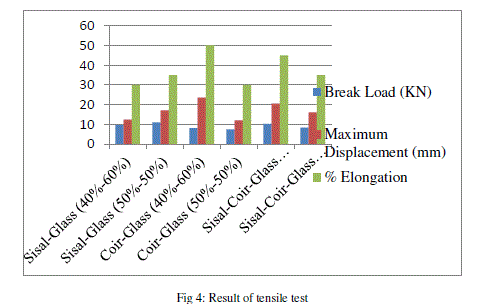 |
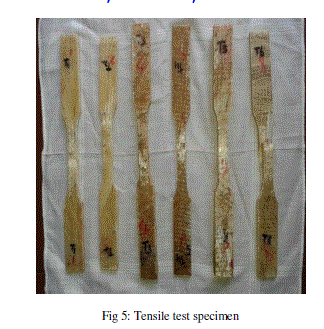 |
| B. FLEXURAL PROPERTIES |
| The Load vs Displacement curve for three different types of composites is shown. The flexural property of Sisal- Coir-Glass composite has high flexural strength.The curve increases linearly with respect to displacement up to the maximum flexural load and then it gets decreased.The adhesion between the sisal, coir and glass with isophthalic polyester is far better than the other two combinations. The flexural modulus of the composite is found from the linear portion of the curve by determining the load and its corresponding displacement which shows sisal-coir-glass hybrid composite has highest flexural modulus when compared to other two composites. |
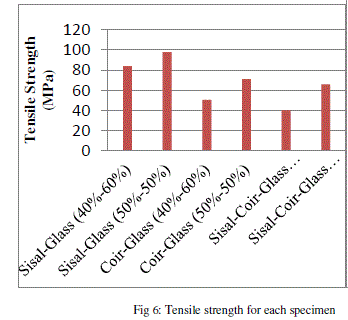 |
| C. IMPACT TEST |
| Impact test is conducted to analyse the impact capability of the different specimens.The impact test is carried out using Charpy impact test machine so that loss in energy is determined. The Sisal-Coir-Glass hybrid composite has high impact strength. The reason for high impact strength is due to the presence of all three (sisal,coir & glass) fibers in alternate alignment of composite.The energy absorbed by each specimen when it is impacted by a heavy blow from pendulum crack is formed. The crack usually travels through the fiber and resin of the composite. So when crack propagates through the composite absorption of energy will be high. |
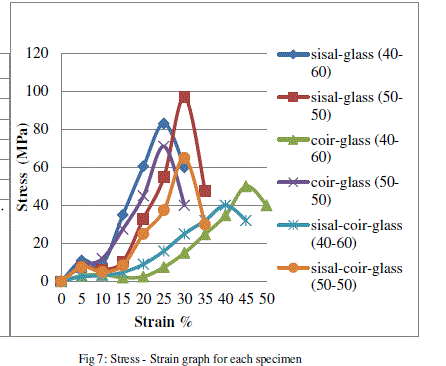 |
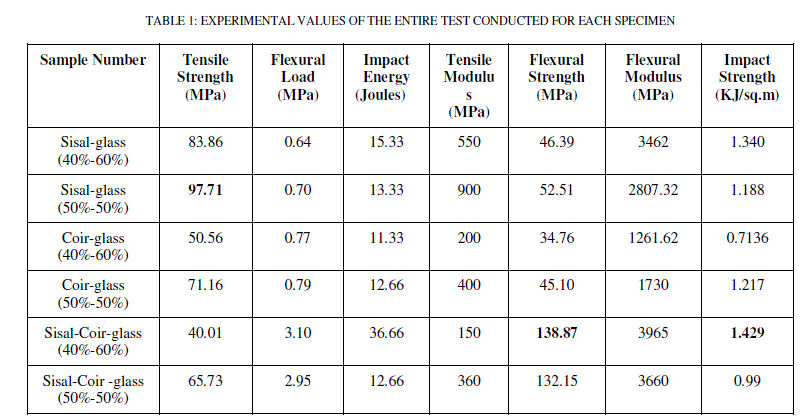 |
CONCLUSIONS |
| From the experiments, the following conclusionsare drawn: |
| The composite with 50% sisal-glass fiber and 50% resin combination has maximum tensile strengthof 97.71 MPa. |
| The breaking load of sisal-glass fiberreinforced composite is found as high (10.285 KN). It is found that breaking load of sisal-glass fiber reinforced composite is 1.10 times higher than sisal-coir-glass fiber reinforced composite and 1.33 times higher than coir-glass fiber reinforced composite. |
| The percentage elongation of coir-glass fiber reinforced composite is found as higher than the other composites,and hence it may have more ductile property in nature. |
| The hybrid with composite with 40% sisal-coir-glass fibers and 60% resin combination has high flexural strength (138.87 MPa) and high impact strength (1.429 KJ/m2). |
References |
|